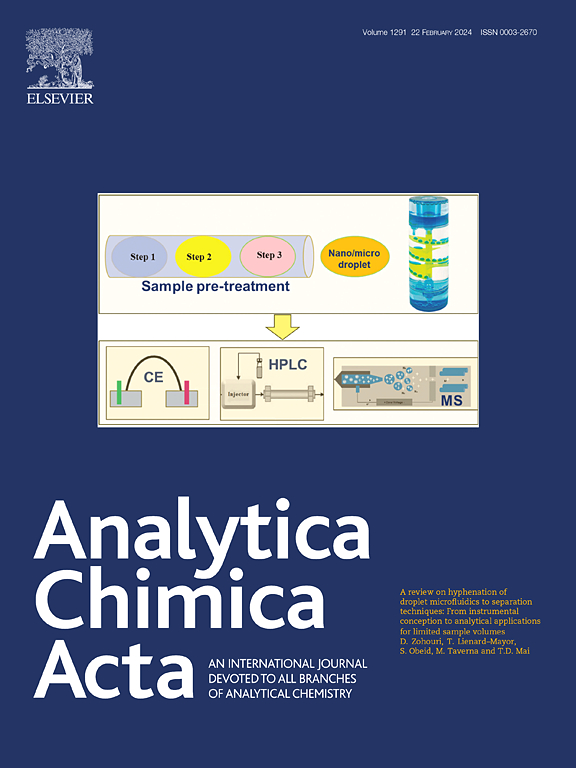用塑料闪烁树脂对乏核燃料后处理TBP相中99Tc的测定
IF 6
2区 化学
Q1 CHEMISTRY, ANALYTICAL
引用次数: 0
摘要
在乏燃料后处理的PUREX过程中,锝-99具有很强的氧化还原特性,是影响铀、钚和镎分离的主要放射性核素。由于样品基质的复杂性和放射性核素的严重干扰,快速、可靠地测定TBP中的99Tc是非常具有挑战性的。结果建立了一种快速准确测定TBP有机相中99Tc的分析方法。首先使用去离子水和四氯化碳的混合物从TBP相中反提99Tc,效率为94.7%,可以直接装载到塑料闪烁树脂(TK-TcScint树脂)上。采用液相闪烁计数法(LSC)直接测定吸附在TK-TcScint树脂上的99Tc。重要的是,首次建立了TK-TcScint树脂上99Tc计数效率的淬火校正。对各种干扰具有优良的去污因子(>;105)在乏燃料溶液中(例如,Sr, Cs, Sm, Fe, Zr, Ru, U)。在TBP相中99Tc的最低检测活性估计为0.09 Bq/L,计数时间为1小时,整个分析过程仅需要约2小时,每批12个样品。意义这种快速可靠的分析方法对TBP有机相中99Tc的监测对于改善PUREX工艺中铀钚分离具有重要意义。更重要的是,采用一体化分离与测量分析的方法,实现乏燃料后处理中99Tc的全自动分离与测量。本文章由计算机程序翻译,如有差异,请以英文原文为准。


Determination of 99Tc in TBP phase in spent nuclear fuel reprocessing with plastic scintillation resin
Background
Technetium-99 is a major radionuclide affecting the separation of uranium, plutonium and neptunium in the PUREX process of spent fuel reprocessing due to its strong redox feature. The rapid and reliable determination of 99Tc in TBP is very challenging, mainly due to the complexity of the sample matrix and the severe interference of radionuclides.
Results
A rapid analytical method for the accurate determination of 99Tc in TBP organic phase was developed in this work. 99Tc was first back-extracted from TBP phase using a mixture of deionized water and carbon tetrachloride with an efficiency of 94.7 %, enabling to directly load to the plastic scintillation resin (TK-TcScint resin). 99Tc adsorbed on the TK-TcScint resin was then directly measured by liquid scintillation counting (LSC). Importantly, the quenching correction for the counting efficiency of 99Tc on the TK-TcScint resin was established for the first time. The excellent decontamination factors for all interferences (>105) in the spent fuel solution (e.g., Sr, Cs, Sm, Fe, Zr, Ru, U) were achieved. The minimum detectable activity for 99Tc in TBP phase was estimated to be 0.09 Bq/L with a counting time of 1 h, and the whole analytical procedure takes only about 2 h per batch of 12 samples.
Significance
This rapid and reliable analytical method is crucial to monitor 99Tc in the TBP organic phase for the improvement of uranium-plutonium separation in the PUREX process. More importantly, the method with integrative separation and measurement analysis would be conducted for fully automated separation and measurement of 99Tc in spent fuel reprocessing.
求助全文
通过发布文献求助,成功后即可免费获取论文全文。
去求助
来源期刊

Analytica Chimica Acta
化学-分析化学
CiteScore
10.40
自引率
6.50%
发文量
1081
审稿时长
38 days
期刊介绍:
Analytica Chimica Acta has an open access mirror journal Analytica Chimica Acta: X, sharing the same aims and scope, editorial team, submission system and rigorous peer review.
Analytica Chimica Acta provides a forum for the rapid publication of original research, and critical, comprehensive reviews dealing with all aspects of fundamental and applied modern analytical chemistry. The journal welcomes the submission of research papers which report studies concerning the development of new and significant analytical methodologies. In determining the suitability of submitted articles for publication, particular scrutiny will be placed on the degree of novelty and impact of the research and the extent to which it adds to the existing body of knowledge in analytical chemistry.
 求助内容:
求助内容: 应助结果提醒方式:
应助结果提醒方式:


